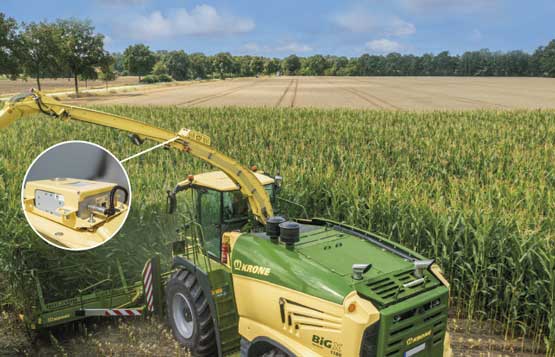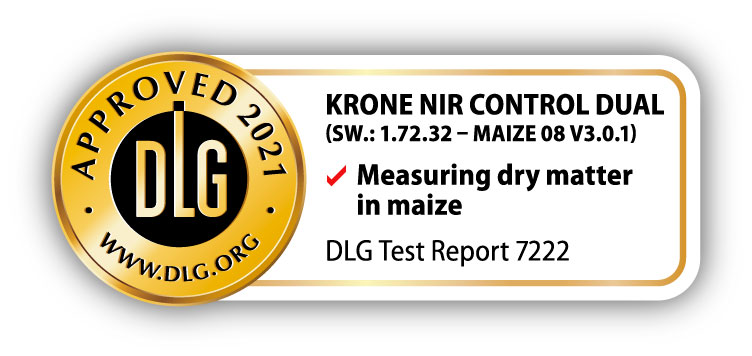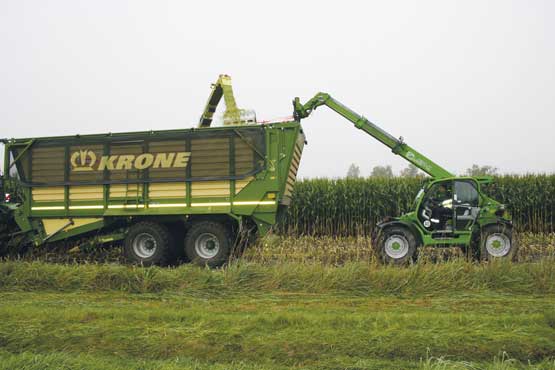Krone NIR Control dual (Software: 1.72.32; calibration model: Maize 08 V3.0.1)
DLG-APPROVED "Measuring dry matter in maize"
The approval
A test mark „DLG-APPROVED for individual criteria“ is awarded for agricultural products which have successfully fulfilled a
scope-reduced usability testing conducted by DLG according to independent and recognised evaluation criteria. The test is intended to highlight particular innovations and key criteria of the test object. The test may contain criteria from the DLG test scope for overall tests, or focus on other value-determining characteristics and properties of the test subject. The minimum requirements, test conditions and procedures as well as the evaluation bases of the test results will be specified in consultation with an expert group of DLG. They correspond to the recognised rules of technology, as well as scientific and agricultural knowledge and requirements. The successful testing is concluded with the publication of a test report, as well as the awarding of the test mark which is valid for five years from the date of awarding.
The DLG test “Mobile sensors measuring dry matter content in crop as this is flowing through the forager spout and passing the sensors” verifies the accuracy of mobile moisture sensors by comparing the sensor readings with results that are obtained by the official reference method (oven-drying method) and by assessing the match range of the paired values. The DLG test on the mobile Krone NIR Control dual sensor (software: 1.72.32; calibration model: Maize 08 V3.0.1, model year 2021) was carried out in September 2021. The sensor was installed to the spout of a Krone Big X 530 forage harvester. To operate the sensor in as wide a range of different maize crops as possible, the forager harvested three different varieties of three different moisture level ranges in two different locations in Lower Saxony. Ten samples were taken from each moisture level range and the sensor readings on the dry matter content of these samples were recorded. In a next step, composite samples were taken from each sample and sent to a lab for analysis. The lab result of each sample served as a reference value which was paired with the corresponding sensor result of which the absolute variation computed.
Other criteria were not tested.
Assessment – Brief Summary
On the whole, the results supplied by the forager spout-mounted KRONE NIR Control dual sensor (software: 1.72.32; calibration model: Maize 08 V3.0.1) showed satisfactory agreement with the results obtained by the official reference method for measuring moisture levels in maize across a dry matter range of 26 % to 43 % DM. The difference between the sensor readings and the lab results was never greater than 3.0 %abs. This applied to all 30 reference testings. In addition to that, in 24 testings, the difference between the two dry matter content measurements was smaller than 2 %abs. None of the sensor readings exceeded the tolerated deviation by more than 4 %abs.
This means that the spout-mounted Krone NIR Control dual (software 1.72.32; calibration model; Maize: 08 V3.0.1) meets all requirements for being awarded the DLG APPROVED quality seal for the indivdiual criterion ‘Measuring dry matter in maize’.
The Product
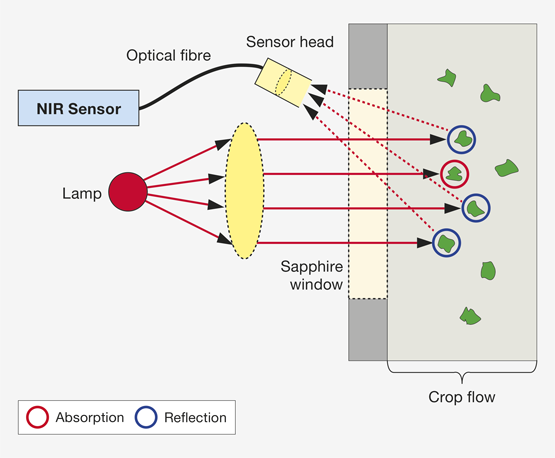
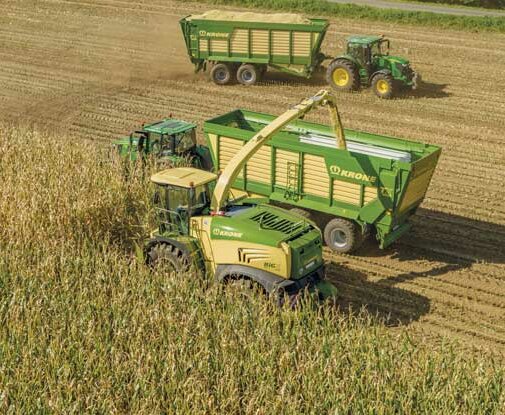
Description and specifications
Sensor
The Krone NIR Control dual sensor is installed on the spout of the forage harvester from where it emits near-infrared light onto the crop stream. As the crop reflects the light, the individual spectrums are computed into information on the nutrient levels in the crop, which is made possible by using advanced calibration curves. The NIR sensor is supplied with various calibration curves that match different crops including fresh maize and grass. It is also able to measure nutrients in slurry.
The advantage of the NIR sensor is that it provides growers with instant and accurate on-site measurements that give information on the quality of the crop without growers having to send samples to a lab. The sensor measures the reflected light once per second and saves the averaged result from the series of measurements.
This data can be georeferenced and communicated via Krone Smart Telematics or from the agrirouter to a farm management software such as NEXT Machine Managment. The yield and nutrient maps can be merged with seed and fertilizer application maps to help growers and agronomists for further planning.
In maize, the NIR sensor supplies information on the following nutrients in addition to dry matter content levels (22 to 52 %):
- Crude fat (1.5 to 4.5 % range)
- Crude fiber (14.0 to 25.0 % range)
- Crude ash (2.5 to 6.0 % range)
- Protein (5.5 to 10.0 % range)
- Sugar (6.0 to 16.0 % range)
- Starch (14.0 to 36.0 % range)
- ADF (19.0 to 29.0 % range)
- NDF (34.0 to 54.0 % range)
The percentages indicate the dry matter content. The tested sensor was calibrated to the ‘Maize 08 V3.0.1’ calibration model (software 1.72.32).
Forage harvester
The forage harvester used in the test was a BiG X 530 equipped with the variable-row Krone EasyCollect 750-2 maize header of a 7.5 m cutting width. The forage harvester model is powered by a 6-cylinder, 12.8-litre MTU R6 engine that delivers 390 kW (530 hp) at 1,750 rpm (Emmission Stage V). The engine is mounted transversely to the direction of travel.
The chopping assembly consists of six 630 mm wide pre-compression rollers and the chopping drum with 36 blades. This assembly allows operators to vary the length of cut between 3 mm and 17 mm. The harvester also had a kernel processor with 250 mm rollers rotating at a 30 % speed differential).
The Method
The DLG test “Mobile sensors measuring dry matter content in crop as this is flowing through the forager spout and passing the sensors” verifies the accuracy of mobile moisture sensors in maize by comparing the sensor readings with results that are obtained by applying the official reference method (oven-drying method).
The spout-mounted sensor is tested in the field as the forager is harvesting and filling a forage wagon. The harvester is set up according to the prevailing harvest conditions. The data for these settings are collected in a number of separate runs prior to the test. In order to cover as wide a range of crops as possible, the forager harvests various maize varieties which reflect at least three different dry matter content ranges.
From each of these dry matter ranges ten samples are taken (photo 4) and the sensor-measured dry matter contents are recorded. Then five representative subsamples are taken from each sample of chopped maize and filled into an appropriate container. The fresh mass of these samples is determined as they are filled into the containers. Then the containers are closed, marked and stored in a cooled cabinet. All five subsamples from each sample are analyzed for fresh matter content by an official lab to the officially recognized method. The lab results obtained from the five subsamples are then used to compute the average dry matter content figure to the official method. This averaged value is the reference value. All averaged reference values are paired with the corresponding sensor readings and the differences between the paired sensor readings and the reference values are computed.
Table 2: The DLG assessment scheme
| Measuring dry matter in maize Evaluation scale for n = 30 pairs | |
| n = number of samples taken x = absolute variation | Evaluation |
| n ≥ 29 with x ≤ 1 % and all x < 4 % | very good (+ +) |
| n ≥ 29 with x ≤ 2 % and all x < 4 % | good (+) |
| n ≥ 29 with x ≤ 3 % and all x < 4 % | satisfactory (o) |
The Test Results in Detail
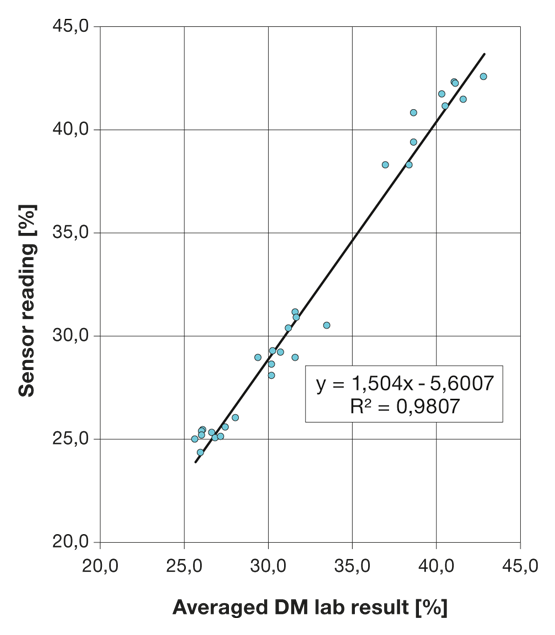
The field test took place at two different locations in Lower Saxony, Germany, in Septemer 2021. Here we were able to harvest three different stands of maize varieties with different dry moisture level ranges. The material was chopped to 6 mm lengths:
- Farmirage
- Hulk
- Ronaldinio
Determining the dry matter content with the KRONE NIR sensor.
Fig. 6 shows the differences between the dry matter readings of the Krone NIR sensor and the official reference values. In total, 30 valid test runs were carried out in three different maize varieties of three different moisture level ranges. The sensor readings are marked red and the lab results are marked blue in the graph. Each lab reference value is assigned a tolerance range of ± 2 %abs.
In all 30 pairs, the difference between the sensor-based and lab-based data never exceeded 3.0 %abs and in 24 of 30 pairs it was even less than 2 %abs.
The mean variation across all pairs is 1.3 %abs. Not one sensor reading exceeded the tolerance range by more than 4 %abs in the DLG test.
Across all test runs, the coefficient of determination relative to the reference measurements was R² = 0.98.(see fig. 5).
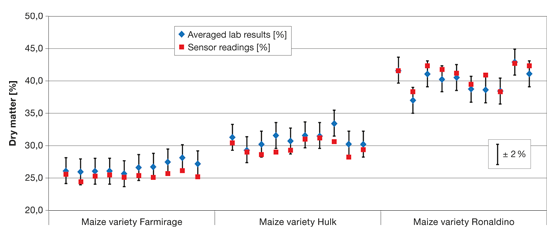
in the oven-drying method
Summary
The Krone NIR Control dual (software: 1.72.32; calibration model: Maize 08 V3.0.1) proved in the DLG test that its dry matter content measurements in maize meet the DLG accuracy standards. Therefore, it is eligible for being awarded the DLG APPROVED seal.
The DLG test ‘Mobile, spout-mounted moisture sensor(s) on a forage harvester for determining the dry matter content of the passing crop’ shows that the Krone NIR Control dual (softwere 1.72.32; calibration model: Maize 08 V3.1.1) on the forager spout produced readings that overlapped across a large range (26 to 43 % DM) with those results obtained by applying the official reference method. In all 30 pairs, the difference between the sensor-based and lab-based data never exceeded 3.0 %abs; in 24 of 30 pairs it was even less than 2 %abs. The mean variation across all pairs is 1.3 %abs. Not one sensor reading exceeded the tolerated variation by more than 4 %abs in the DLG test.
Based on these test results on the individual criterion ‘Measuring dry matter in maize’, the Krone NIR Control dual sensor is awarded the DLG APPROVED quality mark.
Applicant and Test implementation
Manufacturer and Applicant
Applicant:
Maschinenfabrik
Bernard Krone GmbH & Co. KG
Heinrich-Krone-Straße 10
48480 Spelle, Germany
https://landmaschinen.krone.de/english/
Manufacturer:
m-u-t GmbH
Am Marienhof 2
22880 Wedel, Germany
Test implementation
Testing agency
DLG TestService GmbH,
Gross-Umstadt location, Germany
The tests are conducted on behalf of DLG e.V.
DLG test framework
DLG-Approved Test “Moisture measurements in maize” (current as of 2009)
Department
Agriculture
Division head
Dr. Ulrich Rubenschuh
Test engineer(s)
Dipl.-Ing agr. Georg Horst Schuchmann*
* Author
Contact
DLG TestService GmbH - Groß-Umstadt location • Max-Eyth-Weg 1 64823 Groß-Umstadt Germany • Tel.: +49(0)69 24 788-611 • tech@DLG.org

